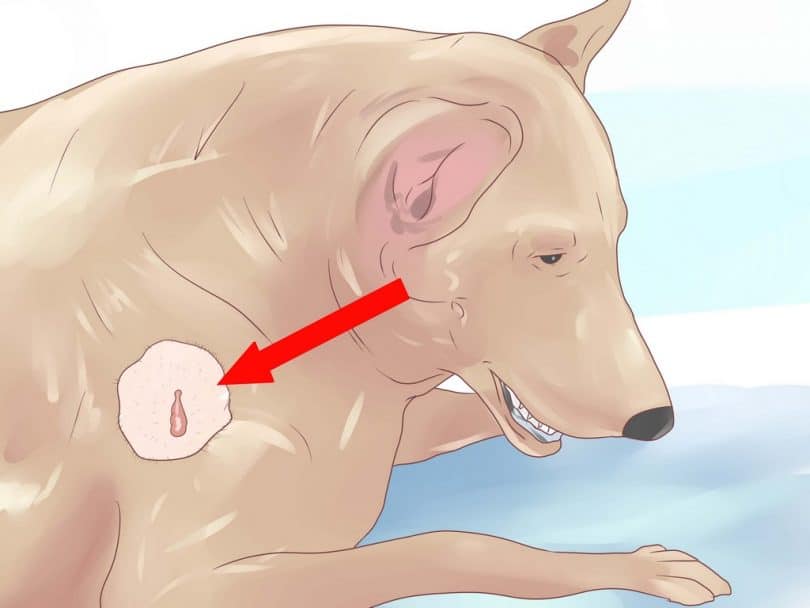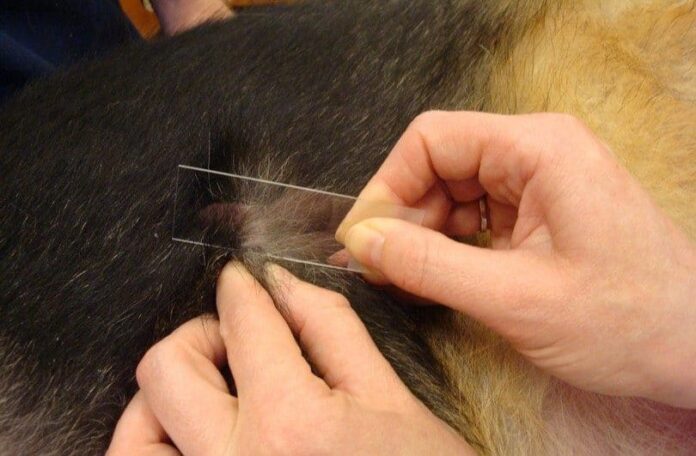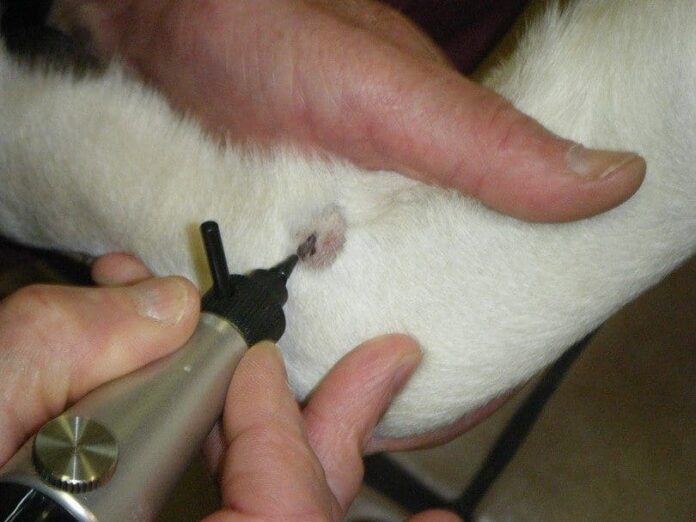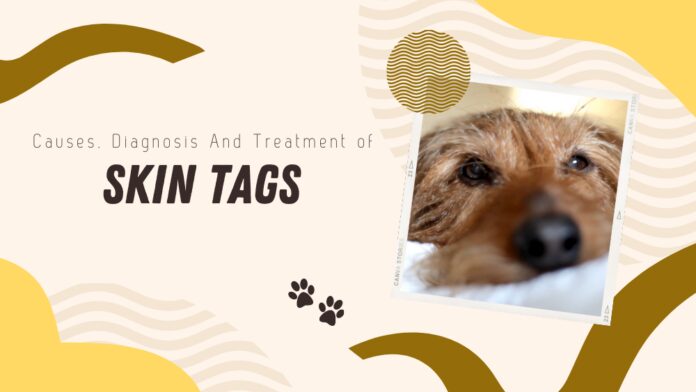You are lounging on the couch watching TV one evening with your companion curled up at your side. You are absentmindedly stroking his back and chest, when suddenly, your fingers brush up against something soft and fleshy.
It bends and folds, and the next thing you know, you are bent over, digging through fur, trying to figure out just what this thing is. It can be disturbing to find such a growth jutting from his chest, but the truth is, skin tags on dogs are quite common.
They are usually nothing to worry about, but they can become a problem. This article will help you to identify them, lessen the chance of them occurring, and walk you through several options for getting rid of them for good.
In a nutshell, skin tags are benign growths that grow out from the body. Usually only a few millimeters long, they lie flat, be round like a mole, or even protrude from the body like a grain of half-cooked rice. They are also known as fibropapillomas and achrochordons, and in truth, they are actually quite common.
Dogs of all ages can develop these ugly little tabs of flesh on their face, chest, armpits, and legs, though the older a dog gets the more likely one is to form. They are often mistaken for tumors or canine skin cancer, but most owners need to not worry.
Sure, finding one in the fur of one of your closest family members can be disturbing, but the truth is, unless it is causing your pet pain or discomfort, they are usually not harmful.
Perhaps it would be best to think of them as soft, misshapen warts than a spreading infection. In fact, by the time you found it, it probably has already grown as far as it ever will. But like any change in health status, it shouldn’t be simply ignored.

You can usually tell the difference between a life-threatening disease and a merely irritating growth by carefully examining the area. Skin cancer will appear as a lesion that has a watery discharge; it will also be painful for your pet at the slightest touch. The lesion may also change in size, texture, and color.
Skin tags, on the other hand, tend to have an extremely flexible base which allows for the upper part of the growth to be moved around with your finger and won’t cause pain unless it is inflamed or infected. A good rule of thumb, however, is “When in doubt, ask your veterinarian.” If your vet cannot tell the difference from a spot check, he or she will perform a biopsy to rule out any malignancy.
Causes of tags
So, you may be asking yourself, “Why do dogs get skin tags?” Well, there aren’t any definitive answers to that question. Many veterinarians and other animal specialists have theorized many different reasons as to why they form. Although the professionals have not been able to solve the puzzle, they do believe that there is a common link to the development of tags and the following factors.
Parasites
There is a long list of parasites that attach themselves to your dog. Fleas, ticks, lice, and mites are the most common, and most owners soon know when their pets have become infested. The unwanted residents will cause itching, and if not taken care of quickly, your dog can damage his skin while attempting to scratch them away.
The damaged skin can become inflamed develop a host of infections and diseases. Once treated, tags can develop after the flesh heals.
Environment
There is so many things in your dog’s environment that can lead to the formation of tags on the skin. Exposure to pesticides, chemicals, acidic soil, and just about anything else that he can come into contact with while romping through the house or exploring the back yard can have an adverse effect on his skin.
A poor fitting or tarnished collar could cause inflammation as well. Just think of all the things that could dry out and irritate your own skin. Those same irritants can get down beneath the coat and do some horrendous damage before it cared for. But even after the initial damage heals, the new flesh especially susceptible to forming an abnormal growth.
Improper skin care
Much depends on the breed, but for the most part, dogs need to be bathed on a regular basis. The dirt and whatever else they’ve tracked into the house has to come out at some point, but there are owners who will bathe their dogs the moment they think their pets are starting to “get a smell.”
The problem with this is that too much washing can inhibit the skin from producing natural oils necessary to keep the skin and coat healthy. Harsh soaps and shampoos can contribute to the development of tags by stripping away the oils and causing the skin to dry out and chafe.
Poor diet
Along with a whole host of medical issues, a dog that is not properly fed can easily develop skin malformations. If he isn’t getting the right nutrition, or if he is eating something that he shouldn’t be eating, his weakened immune system could cause rashes, cracks in the skin, and other outbreaks that could eventually lead to tag growth.

Proper food and routine visits to the vet can go a long way in eliminating diet as a factor.
Genetics
Like so many medical conditions, skin tags can be an inherited problem. So, if this is something that is in your dog’s breeding line, it is already too late. There is nothing you can do to stop them from occurring, but you may be able to lessen the chances of them by taking preventative measures outlined in this section.
In the meantime, monitor your pet if the tags become infected or otherwise bothersome, take him to a veterinarian. Most veterinarians have had plenty of practice slicing them off.
Monitoring tags
There is a good chance that if you find one tag on your dog, then you’ll probably find some more. You should give him a thorough grooming every day. While you brush him, check out all the typical areas where these nasty things can form, and then run your fingers through the coat. Make sure to explore armpits and creases in the flesh, such as behind ears, beneath the jawline, and around the base of the tail.
If you search deep enough, and often enough, you should be able to find any suspicious bumps that may require further examination. If you believe that the tag could be a problem. Don’t hesitate to ask your vet. He or she should be able to tell you if something should be done about them.

If your vet informs you that the tag is not a threat, you should still continue to monitor it for changes. It is rare, but some of them, especially ones that form around the lips and nose, can become cancerous. So watch for any changes in color or size. Also, you should pay attention to how your dog treats the growth. If he continually scratches or bites at it, it may be causing him discomfort.
Tags that have been cut or abraded can become inflamed or even infected if not treated immediately. As stated earlier, these formations aren’t typically a threat to your pet’s health, but sometimes the best way to deal with them is to get rid of them.
Large tags can pose a problem either because of their size, their location, or a combination of both. Dogs may scratch or gnaw at them, or they could get caught on a chain link fence or other object that your pet likes to crawl through or beneath.
Torn tags can bleed profusely, and are prone to infection. Tags that form on the tail are highly vulnerable to damage. Take the time to examine these on a daily basis, and if they appear to be affecting your dog, you should consider having them removed.
Removal of tags
Believe it or not, there are a few options when it comes to dog skin tag removal. The most obvious choice is to make an appointment with a veterinarian and have the annoying thing excised. One problem with this choice is that it the procedure could cost you several hundred dollars, so you may not be able to afford it.
The age of your dog may also play a factor. Your vet may tell you that he may be too old to justify the expense. Don’t be discouraged if you think money or age will in the way of your favorite fur ball living tag-free. There is another option.
Veterinarians
For the most part, removing one of these bothersome nodes is an outpatient affair. You will go into the room with your dog, and while he lies on the table, the vet applies a local anesthetic to numb the area around the tag. If he becomes aggressive or overly skittish, you may have to hold him down throughout the procedure.
Once the anesthetic has set in, the vet will slice the tag away. One good thing about this approach is that your dog will not feel any pain, and as soon as the vet steeps away from the table, the two of you can be on your way home.

In this type of procedure, there is little cutting, so most vets will not sew the area shut. You will need to monitor the wound over the next week to ensure that the patient is healing as he should. Also, make sure that he doesn’t scratch the area as it heals, because that will slow healing, and even perhaps induce another tag. There will be a scar, of course, but it will fade in time.
Home remedies
A problematic tag of skin will continue to cause your dog discomfort regardless of its age or the amount of money that you might have for the time being. Or, perhaps you have just gotten sick of looking at the ugly thing dangling from your buddy’s chest and you want to take matters into your own hands. You can’t just reach over and snip off the offending mass with a pair of toenail clippers, but it is possible for you to get rid of it without ever leaving your home.
The methods detailed below are two of many suggestions available on how to remove them, but before you decide on your approach, you should give it plenty of thought. Do the steps sound logical to you? Does it sound like it won’t harm your dog? Are you willing to see the steps through all the way to the end? If you answered “yes” to these questions, then you can give it a try unless the tag appears around the mouth or the eyes. These should only be removed by your vet.
Cutting and cauterizing
This technique is similar to how a veterinarian would approach the removal of a tag. It requires a trusting dog, a partner that can keep a firm grip on him, and for you to keep a steady hand throughout. The advantages to this method is that it is over in a matter of minutes; but you shouldn’t try it if the sight of blood, or the idea of cutting your pet disturbs you.
Before you start, make sure that you have following:
- a pair of curved (mayo) scissors
- a disposable razor
- isopropyl (rubbing) alcohol
- 10% iodine solution
- bottle of water (12 oz)
- cotton balls
- plastic bowl wide enough for scissors to lay in
- electro-cauterizing pen or soldering iron
- bandages
After your partner has calmed your dog, trim and shave the hair around the tag and then swab the area with a cotton ball soaked in alcohol. Next, sterilize the scissors by letting them sit for at least a minute in a bowl of water and a teaspoon of iodine. Then, with the dog held firm, cut the tag at its base and then press a bandage to the wound to staunch the bleeding.
Finally, cauterize the place that you cut with the pen or soldering iron by touching the hot end to the wound for two seconds. Cover it with a bandage and monitor it throughout the week. If you have done this properly, the tag will not grow back.
Tying off tags
This procedure is most effective for tags that protrude enough that you can pinch it between your fingers. It may seem a little strange at first, but it is rather simple to do and does not involve cutting your beloved family member. Before you start, make sure that you have someone with you who has a good relationship with your dog and the strength to hold him down.
You will also need to gather the following:
- a foot of fishing line, or dental floss
- a pair of scissors
- a disposable razor
- isopropyl (rubbing) alcohol
- cotton balls
- a cone collar (like the one vets use after spaying/neutering)
Once you have gathered your materials, have your partner hold your dog down while you trim and shave the hair around the tag. You don’t need a bald patch; however, make sure there is no hair around the base of the formation.
Then, dab the area generously with isopropyl alcohol. You and your partner should be talking and stroking him to ensure that he remains calm and that his movement is kept to a minimum. By this time, he has sensed that something unusual is about to happen, and he probably won’t like it.
As long as he is calm, tie the fishing line as tight as you can around the base of the tag. Wrap it around several times, and tie it once again. This will hurt for a minute or two, but he will soon forget that it is there. Place the collar around his neck (or a dog shirt if it’s in the chest area) to keep him from biting at the tag as it swells up. It will likely turn a shade of purple that causes you to regret your decision, but in three days, it will begin to shrivel. A few days later, it will fall off, leaving hardly a mark.
Conclusion
Skin tags can be unsettling for any dog owner. They are unpleasant to look at, and some people may even view you as a poor master because one or more has formed on your companion. Take heart that they are quite common, and they usually aren’t a serious threat to your pet’s overall health, though they can be symptoms caused by a different issue.

Tags should be monitored for damage or inflammation, and if found, it should be brought to your vet’s attention immediately. And remember, you have more than one option to have the tag removed, if necessary. So, now that you know what skin tags are and what you can do about them, you can be prepared the next time you find one.




